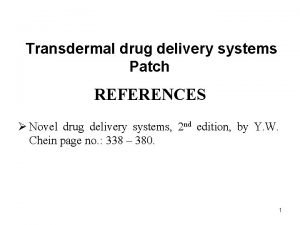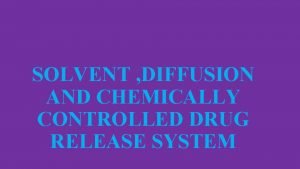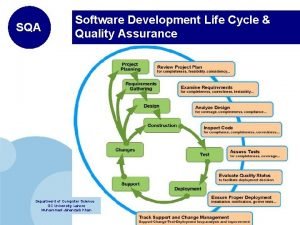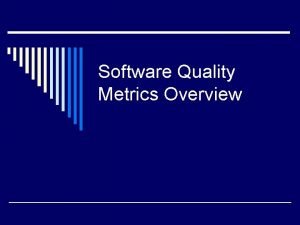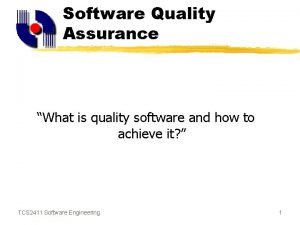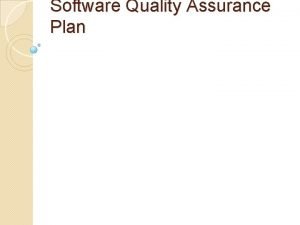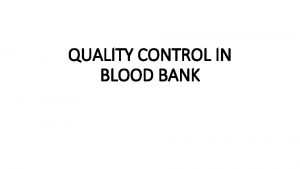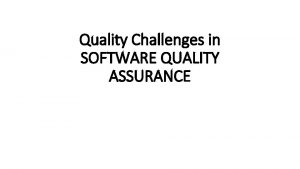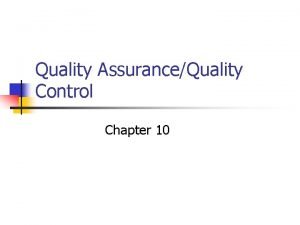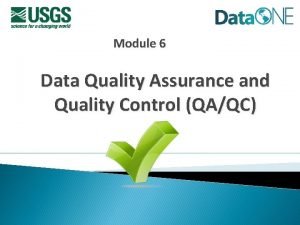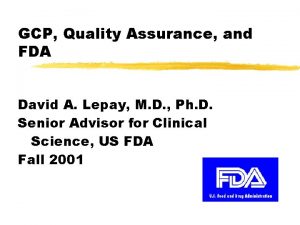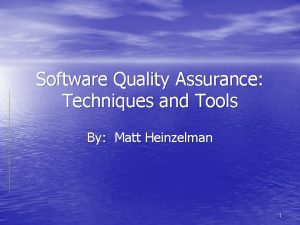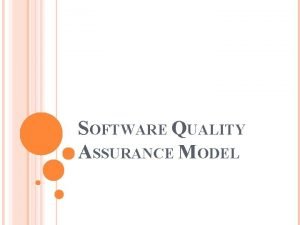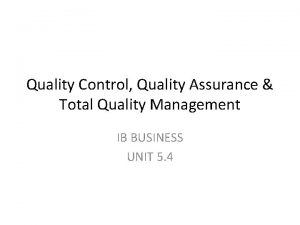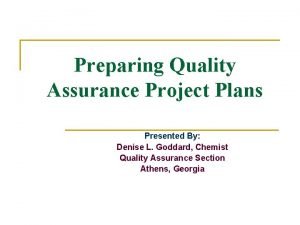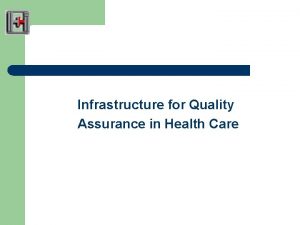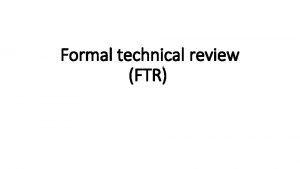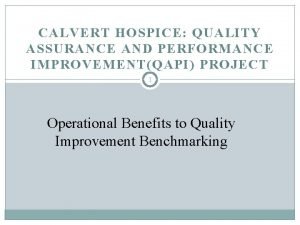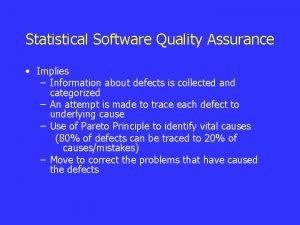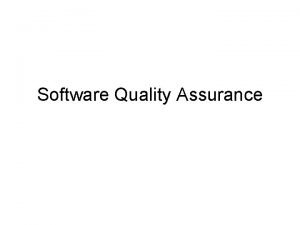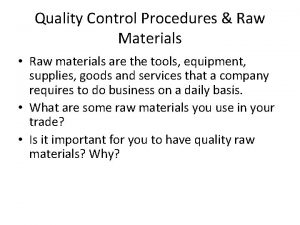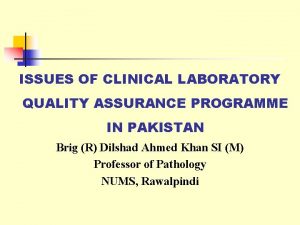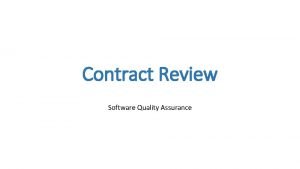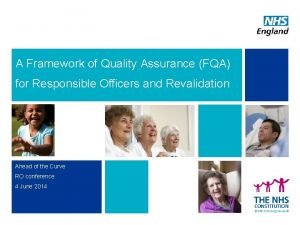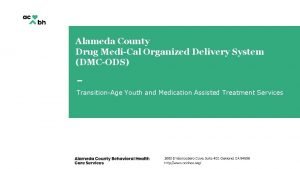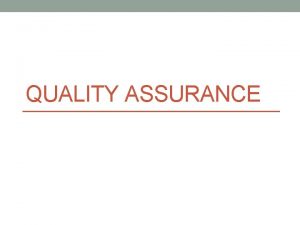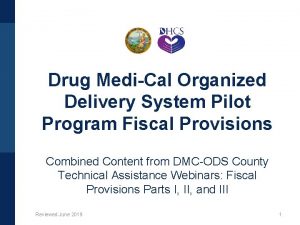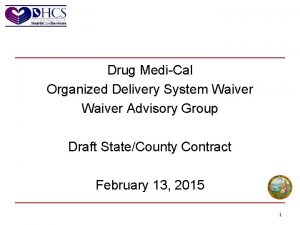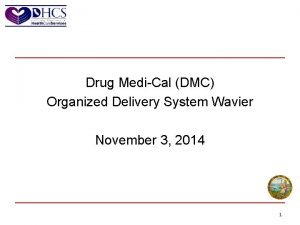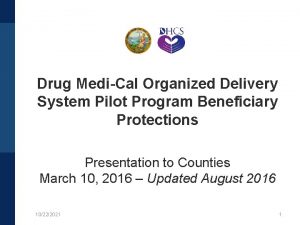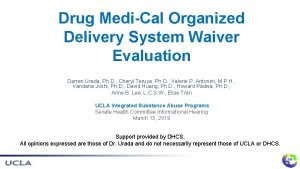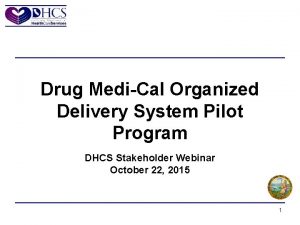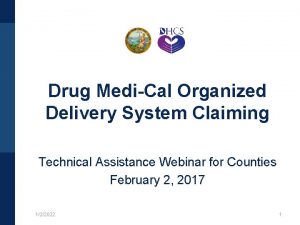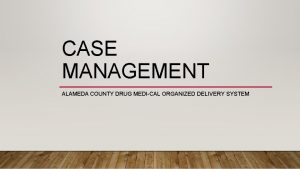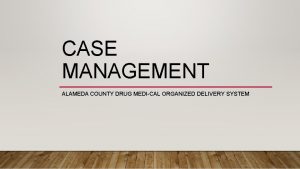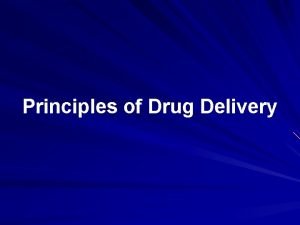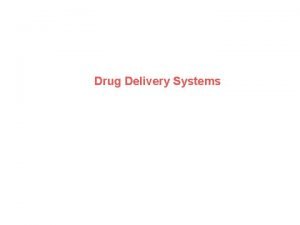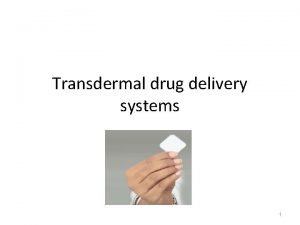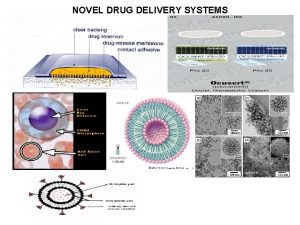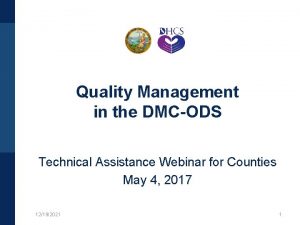Drug MediCal Organized Delivery System DMCODS QUALITY ASSURANCE































































- Slides: 63

Drug Medi-Cal. Organized Delivery System (DMC-ODS) QUALITY ASSURANCE (QA) REQUIREMENTS Phase B Presented by California Institute for Behavioral Health Solutions Revised by Rod Libbey, MA CIBHS Consultant April 30 th, 2020

A THREE PHASE TRAINING SERIES Phase A § Introduction to 42 CFR Part 438 Quality Improvement (QI) requirements. § Addressing QI requirements in a County plan. Phase B § Practical implementation of organizational structure and operation of the QI Committee (QIC).

Learning Objectives 1. Quality Improvement Committee (QIC) CONTEXT: Clarify the primary 2. QIC STRUCTURE: Identify at least 3 options for the structure, process and 3. QIC CONTENT: Identify at least 5 issues that a QIC is required to address, and 4. purpose of a QIC in the context of an Organized Delivery System. function of a QIC capable of accomplishing its primary purpose. how they relate to its primary purpose. Identify at least 5 databases relevant to QIC monitoring duties. 5. Identify at least 3 differences between DMC-ODS requirements and Specialty Mental Health (MH) requirements. 6. Identify issues for Phase C training sessions.

THE QUALITY IMPROVEMENT COMMITTEE (QIC) IN ITS ORGANIZATIONAL CONTEXT

ENTITLEMENT • Medi-Cal (MC) establishes entitlements. • MC beneficiaries are entitled to services that are – Medically Necessary, – Accessible, and – Meet Quality Standards

DMC-ODS OBLIGATIONS • DMC-ODS is obligated to meet the substance related entitlements of all MC beneficiaries in its county who seek services. – whether or not its Medi-Cal funds have been depleted in any given year. • This obligation applies to the DMC-ODS, not necessarily to each of its providers.

Quality Improvement Program’s (QIP) PRIMARY PURPOSE A Quality Improvement Program’s (QIP) primary function is to assist DMC-ODS administration in meeting its obligations to beneficiaries for access to services and quality of care.

5 Mandated QIC Functions • recommend policy decisions • review and evaluate the results of QI activities • institute needed QI actions • ensure follow-up of QI process • document QI committee minutes regarding decisions and actions taken Source: DHCS Special Terms and Conditions, Item 156 (b).

WHILE MEETING ITS PRIMARY PURPOSE, A COUNTY’S QI PROGRAM CAN… • promote organizational development (e. g. , efficiency, productivity, interagency relations. . . ) • promote quality of clinical practices (e. g. , accurate diagnosis, fidelity to evidence based practice methods, treatment plans that are individualized and change when client needs & wishes change. . . ) • improve client outcomes • promote / maintain credibility in the community • minimize legal liabilities (e. g. , avoid malpractice suits, prevail if malpractice suits are brought. . . ) • maintain licensure/certifications

PRO FORMA IMPLEMENTATION • Focusing on seeing that every “i” is dotted and every “t” is crossed • Meeting “the letter of the law” without addressing “the spirit of the law” or substance • Striving primarily to show that QI work was done as required by outside agencies

CONSEQUENCES OF PRO FORMA IMPLEMENTATION • The QI Committee and QI staff will have little credibility and little influence in the organization beyond dotting i’s and crossing t’s. • The QI Committee and QI staff will have marginal credibility with external auditors. • Cost/benefit ratio of the QI effort is limited.

WHAT DOES THE QIC NEED TO BE EFFECTIVE? • backing by an Executive Director committed to accessibility and quality of services • willingness to respectfully speak truth to power within the agency • positive relationships with operations chiefs and middle managers who need to be persuaded to act on QIC findings and recommendations

QIC STRUCTURE What will be the composition and authority of your county’s QIC?

QIP REQUIREMENTS “Describe the County’s Quality Management and Quality Improvement Programs. ” - From STC Attachment Z, PART II: Sec. 12 Quality Assurance The description must include…

QIP REQUIREMENTS (cont’d) “…a description of the Quality Improvement (QI) Committee (or integration of DMC-ODS responsibilities into the existing MHP QI Committee). ” FOR EXAMPLE… • Composition: Who will be “ex officio” QIC members? • Leadership: Which member will be the Chairperson? • Authority Relations: To whom does the Chairperson report? • Scheduling: How often will the QIC meet?

QIP REQUIREMENTS “…a description of the Quality Improvement (QI) Committee (or integration of DMC-ODS responsibilities into the existing MHP QI Committee). ” FOR EXAMPLE… § Will the QIC establish practice standards? § If so, how will they be developed? § What data sources will the QIC review to determine whether or not standards have been met? § To whom will review findings be reported? § Who will develop and evaluate implementation of Corrective Action Plans?

QIC COMPOSITION Who will be “ex officio” members of the QIC? • The County Department Director? • A QI Administrator? • An Operations Chief? • A Finance Director? IT Chief? • A Chief Authorization Reviewer? • Middle Managers at specified service sites? • Administrators of partner agencies?

QIC COMPOSITION Who will be selected members of the QIC? • Service staff representatives? • Consumer representatives? • Family member representatives? • A risk management attorney or County Counsel representative?

The QI Administrator’s Role A Broadly Defined Approach (examples) Tasks: • leading, organizing and managing the QI process • setting the direction for quality activities at the agency • identifying processes that are not working and making them better (clinical practices, accountability, communications…) Responsibilities: • assuring that the agency achieves its mission • assuring that clients achieve their desired outcomes • aligning the agency’s day-to-day work with the requirements of external standards and regulations (accreditation, Medi-Cal, EQRO. . . ) • assuring compliance with agency policies and procedures

The QI Administrator’s Role A More Specifically Defined Approach (examples) Tasks: • conduct chart reviews • create, administer and interpret survey data • write, receive and distribute reports on agency activities Responsibilities: • assure compliance with. . . (e. g. policies, procedures…) • assure proper documentation • assure that paperwork is sent through the right channels on time • minimize audit disallowances • assure optimal productivity and revenue generation • assure achievement of agency objectives (if the agency has specific, measurable objectives)

AN EFFECTIVE QIC The effectiveness of QIC members is likely to vary according to: • professional or technical preparation in the practices being monitored • professional or technical preparation in QI procedures, research methodology and data analysis • commitment to continuing education • relationships with operations managers • persuasive “people skills”

WHAT DOES A QIC NEED TO INFLUENCE QUALITY OF CARE? • explicit quality of care standards – some will be provided by EQRO – some will be provided by DHCS – some should be developed within the organization to address its local issues • access to the codified manuals used to establish evidence-based practice methods • authorization to gather information throughout the agency relevant to these standards

KNOWLEDGE BASE OF THE EFFECTIVE QIC MEMBER Knowledge of… • QI processes (e. g. , chart reviews, data collection, data management, data analysis, report writing. . . ) • external standards and regulations • organizational structure, dynamics and development • clinical practices (e. g. , diagnostic criteria, structured clinical methods, elements of treatment planning, evidence based practices, clinical documentation) • client needs and client rights

BALANCING AUTHORITY AND RESPONSIBILITY What will the QIC or QI Administrator be held responsible for? • Assuring that standards and regulatory requirements are met? • Quality of services? • Staff compliance with agency policies? • Quality of case documentation? • Validity/reliability of QI data & reports? • Fair and effective Corrective Action Plans?

BALANCING AUTHORITY AND RESPONSIBILITY Will the QIC or QI Administrator have the authority to direct the practices of: • Middle Managers? • Practitioners / Service Staff? • Clerical Support Staff? • QIC members? • Anyone? If so…Some Practices? Any Practices?

BALANCING AUTHORITY AND RESPONSIBILITY Will the QIC or QI Administrator have the independent authority to report uncensored findings to: • the Department’s Executive Director? • Middle Managers? • Practitioners / Service Staff? • External Organizations?

QIC CONTENT WHAT MUST BE ADDRESSED BY A COUNTY’S QUALITY IMPROVEMENT COMMITTEE?

7 Mandated QIC Content Issues i. Timeliness of first initial contact to face-to-face appointment ii. Timeliness of services of the first dose of NTP services iii. Access to after-hours care iv. Responsiveness of the beneficiary access line v. Strategies to reduce avoidable hospitalizations vi. Coordination of physical and mental health services with waiver services at the provider level vii. Assessment of the beneficiaries’ experiences viii. Telephone access line and services in the prevalent non-English languages. Source: DHCS Special Terms and Conditions, Item 156 (b).

4 Mandated Types of Data …to be reviewed by QIC at least quarterly i. Number of days to first DMC-ODS service at appropriate level of care after referral ii. Existence of a 24/7 telephone access line with prevalent non- English language(s) iii. Access to DMC-ODS services with translation services in the prevalent non- English language(s) iv. Number, percentage of denied and time period of authorization requests approved or denied Source: DHCS Special Terms and Conditions, Item 156 (c).

What database will your QIC access in order to determine… “…number of days between referral/assessment and first DMC-ODS service/follow-up appointment”?

What database will your QIC access in order to determine… “…the availability of a 24/7 telephone access line with prevalent non-English language(s)”?

What database will your QIC access in order to determine… “…access to translation services in the prevalent non-English language(s)”?

What database will your QIC access in order to determine… “…number and percentage of denied authorization requests and time period of approved or denied authorization requests? ”

AUTHORIZATION Authorization is a step in “Client Flow”… • Referral • Assessment • Authorization • Placement • Transitions to another level of care Reauthorizations at least every six mos. (annually for NTP services)

AUTHORIZATION IS PART OF A DEPARTMENT’S UTILIZATION MANAGEMENT PROGRAM

UTILIZATION MANAGEMENT “Counties will have a Utilization Management (UM) Program assuring that beneficiaries have appropriate access to substance use disorder services; medical necessity has been established and the beneficiary is at the appropriate ASAM level of care and that the interventions are appropriate for the diagnosis and level of care…. ” • Source: State DHCS Terms and Conditions, 156(d)

UTILIZATION MANAGEMENT “Counties shall have a documented system for collecting, maintaining and evaluating accessibility to care and waiting list information, including tracking the number of days to first DMC-ODS service at an appropriate level of care following initial request or referral for all DMC- ODS services. ” Source: State DHCS Terms and Conditions, 156(d)

MEDICAL NECESSITY • Client has a DSM diagnosis for Substance. Related and Addictive Disorders (other than tobacco related or gambling disorders)… – or is at risk for developing substance use disorder (if under age 21) • Client meets ASAM Criteria for the planned/assigned Level of Care. – Source: State DHCS Special Terms and Conditions 156(d)

MEDICAL NECESSITY DMC ODS Medical Necessity is different than MC Medical Necessity for Specialty Mental Health Services.

…a description of the QIC will address “monitoring of accessibility of services” ACCESSIBILITY IS NOT MERELY AVAILABILITY

ACCESSIBILITY IS NOT MERELY AVAILABILITY An available service is accessible if … • people know about it. • people can get to it (geographical distance, transportation access). • disabled people can enter and use the facility. • staff speak the language of people coming to the program or translation is available. • it’s open when clients can come to it.

ACCESSIBILITY IS NOT MERELY AVAILABILITY (cont’d) “The monitoring of accessibility of services outlined in the Quality Improvement Plan will at a minimum include: § Timeliness of first initial contact to face-to-face appointment § Frequency of follow-up appointments in accordance with individualized treatment plans § Timeliness of services of the first dose of NTP services § Access to after-hours care”

ACCESSIBILITY IS NOT MERELY AVAILABILITY (cont’d) Monitoring of Accessibility (cont. ) § Responsiveness of the beneficiary access line § Strategies to reduce avoidable hospitalizations § Coordination of physical and mental health services with waiver services at the provider level § Assessment of the beneficiaries’ experiences, including complaints, grievances and appeals § Telephone access line and services in the prevalent non-English languages. ”

STRATEGIES FOR IMPROVING ACCESS (Examples) (1) Add staff positions/hours or contractor services with needed skills in specific geographic areas; (2) Provide services nights and weekends; (3) Allow flex hours, part-time staff, per diem staff, and varied shifts to accommodate staff and client needs for treatment/rehab access; (4) Provide special programs such as loan forgiveness, structured internships to bring in new clinicians to workforce; (5) Use technology to enhance access/training/consultation – such as video conferencing, translation lines/video, telemedicine/psychiatry, therapies to provide services to remote areas and in a variety of languages.

COLLABORATIVE RELATIONSHIPS “The DMC-ODS has developed strongly collaborative programs/relationship with the following providers to enhance access to care and meet a broad array of client ancillary service needs. ” Source: California EQRO Draft “Key Components Standards and Review Tool” 6/5/17

COLLABORATIVE RELATIONSHIPS WITH WHOM? • Primary Care Providers/Clinics • Hospitals and/or Emergency Rooms • Mental Health Programs and MH Plans for cooccurring disorders • Child Welfare/Human Services • Educational Systems (K-12, vocational, community college, higher education) • Law Enforcement/Criminal Justice

COLLABORATIVE RELATIONSHIPS WITH WHOM? • Public Health/Health Department • Medi-Cal Health Plans • Community-based Organizations such as meals on wheels, Goodwill, etc. • Faith-based Organizations • Vocational Training and Job Placement • Housing Authority • Self-Help Organizations and Networks

EVIDENCE OF COLLABORATIVE RELATIONSHIPS (examples) • • Shared Grants DMC ODS Planning and implementation reports DMC ODS initiatives, trainings and outcome reports MOUs with Organizations Interagency Referral Protocols Examples of Joint Initiatives Committee Minutes On Site Review Observations/Sessions: Staff and partners report and can give examples of how the DMC ODS integrates services with primary care, substance abuse, criminal justice, schools, etc.

TRACKING NO-SHOWS, CANCELLATIONS, 1 ST APPOINTMENTS “DMC-ODS Tracks and Trends No Shows, Cancellations, and ideally First Appointments Offered” Source: California EQRO Key Components Standards and Review Tool Draft 6/5/17

TRACKING NO-SHOWS, CANCELLATIONS, 1 ST APPOINTMENTS What to track, by program unit… • Rate of No Shows/Cancellations • What are the barriers to care • Impact of no-shows, cancellations, and barriers on clients • Type of no shows/cancellations (e. g. client initiated or staff cancellations)

EVIDENCE OF TRACKING (examples) Use of: • routine reports • special surveys • focus groups Review records of: • automated and clinician/staff calls backs • home visits or other outreach for high risk clients • text messaging reminders • transportation, childcare, school and community based service access • evaluating effectiveness of therapeutic alliance or appropriateness of care when clients are dropping out of treatment

EVIDENCE BASED PRACTICES “How will the counties ensure that providers are implementing at least two of the identified evidence based practices? What action will the county take if the provider is found to be in non-compliance? ” - Source: STC’s, Attachment Z, Item #13

Evidence of Using Evidence Based Practices • • Training staff to use specific EBP’s Observing staff with clients Fidelity studies Reviewing charts for descriptions of staff interventions

DATABASES 3 B – A variety of data sources are Used to Inform Management and Guide Decisions -Source: EQRO Draft “Key Components Standards and Review Tool” 6/5/17

OTHER DATABASES PROVING EVIDENCE Examples of reliable and valid data may include: • client survey tools particularly the UCLA experience of care survey • claims data • timeliness data • outcome data • Cal. OMS data • call center database • focus groups • productivity data • fiscal data • demographic data • clinical services data

GRIEVANCES & APPEALS …a description of the QIC…will address “how beneficiary complaints data shall be collected, categorized and assessed for monitoring Grievances and Appeals. ”

GRIEVANCES & APPEALS “Each County shall have an internal grievance process that allows a beneficiary, or provider on behalf of the beneficiary, to challenge a denial of coverage of services or denial of payment for services by a participating County. The Department of Health Care Services will provide beneficiaries access to a state fair hearing process…” – DHCS Special Terms and Conditions #128 (f)

GRIEVANCES AND APPEALS • How will beneficiaries be informed of grievance/appeal (G/A) procedures? • Will G/A explanations be provided in multiple languages? Which ones? • Where will informing materials be posted? How will they be provided to beneficiaries? • How will records of grievances/complaints be kept? • Will a dedicated staff member have primary responsibility for G/A or will it be one of someone’s various duties? • How will service providers be trained on the G/A process?

CORRECTIVE ACTION PLANS SHOULD EXPRESS… • WHICH standard was not met? • WHAT were the findings of noncompliance? • WHO will be responsible for the implementing the corrective action? • Operations Chief? Middle Manager? Unit Supervisor?

CORRECTIVE ACTION PLANS SHOULD CLEARLY EXPRESS… WHAT is/are the required corrective action(s) to be taken? • • Training? Supervision based approaches? Case based consultation? Policy / procedure changes? Change in priorities? Reallocation of resources? Staff reassignments? Change staffing pattern? Increased monitoring and feedback of findings? WHEN is the corrective action to be completed? HOW will the improvement be maintained and monitored?

In Closing… A Quality Improvement Program’s primary function is to assist DMC ODS Administration meet its obligations to beneficiaries for access to services and quality of care.

NEXT STEPS For a comprehensive review of currently approved DMC-ODS Implementation Plans, including their Quality Improvement components, see… http: //www. dhcs. ca. gov/provgovpart/Pages/ County-Implementation-Plans-. aspx

QUESTIONS?
 Delivery quality assurance
Delivery quality assurance Perform quality assurance
Perform quality assurance Project quality management pmp
Project quality management pmp Quality metrics pmp
Quality metrics pmp Quality improvement vs quality assurance
Quality improvement vs quality assurance Quality improvement vs quality assurance
Quality improvement vs quality assurance Quality assurance concepts
Quality assurance concepts Washington medical quality assurance commission
Washington medical quality assurance commission Challenges of novel drug delivery system
Challenges of novel drug delivery system Transdermal drug delivery system
Transdermal drug delivery system Lacrisert adalah
Lacrisert adalah Advantages of controlled drug delivery system
Advantages of controlled drug delivery system Vtdf framework
Vtdf framework Accidental adulteration definition
Accidental adulteration definition Sqa life cycle
Sqa life cycle Quality assurance theory
Quality assurance theory Defect arrival pattern
Defect arrival pattern Software quality assurance iso standards
Software quality assurance iso standards Sqa plans
Sqa plans Quality control in blood banking
Quality control in blood banking Software quality challenges
Software quality challenges What is quality control
What is quality control Iuqb
Iuqb Contoh quality assurance di rumah sakit
Contoh quality assurance di rumah sakit Pharmacovigilance quality assurance
Pharmacovigilance quality assurance Quality control definition
Quality control definition Lqa quality assurance
Lqa quality assurance Principles of quality assurance
Principles of quality assurance International network for quality assurance agencies
International network for quality assurance agencies Software quality assurance conference
Software quality assurance conference Gcp quality assurance
Gcp quality assurance Flight operational quality assurance program
Flight operational quality assurance program European quality assurance standards
European quality assurance standards Content of distribution records of product
Content of distribution records of product Software quality assurance notes
Software quality assurance notes Aviation maintenance quality management
Aviation maintenance quality management Difference between bpr and tqm
Difference between bpr and tqm Pillars of quality management system
Pillars of quality management system Software quality assurance tools and techniques
Software quality assurance tools and techniques Software quality assurance models
Software quality assurance models Statistical quality assurance in software engineering
Statistical quality assurance in software engineering Quality assurance coaching techniques
Quality assurance coaching techniques Total quality assurance
Total quality assurance Pcb
Pcb Quality assurance instruments
Quality assurance instruments Qat quality assurance testing
Qat quality assurance testing Emmett mitchell engineering
Emmett mitchell engineering Epa requirements for quality assurance project plans
Epa requirements for quality assurance project plans Farm quality assurance
Farm quality assurance Infrastructure quality assurance
Infrastructure quality assurance What is a formal technical review and why is one conducted?
What is a formal technical review and why is one conducted? Quality control card
Quality control card Hospice quality assurance
Hospice quality assurance Nche quality assurance framework
Nche quality assurance framework Call may be monitored for quality assurance
Call may be monitored for quality assurance Statistical software quality assurance
Statistical software quality assurance Quality assurance mission statement
Quality assurance mission statement Defect amplification and removal
Defect amplification and removal Raw materials quality control
Raw materials quality control Quality assurance powerpoint
Quality assurance powerpoint Nursing quality assurance commission
Nursing quality assurance commission External quality assurance in clinical laboratory
External quality assurance in clinical laboratory #1 contract review software
#1 contract review software Fqa quality assurance
Fqa quality assurance









